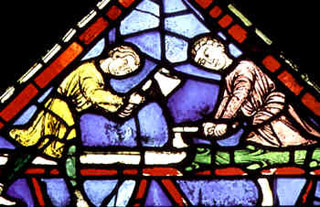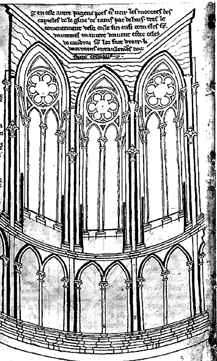The second half of the 12th century saw a boom in building activity in the Ile de France region, the beginning of what was later to become known as Gothic art. In Saint-Denis, Sens, Paris, Laon and Noyon, great building projects were undertaken to enlarge and embellish old cathedrals, bringing them into line with the new architectural style. Chartres could not stand apart from this flurry of activity, and the renovation of the main portal was begun shortly before the middle of the century.
Another fire which destroyed part of the cathedral on the 10th of June 1194 provided an opportunity for the cathedral to be completely rebuilt. The treasure of relics was saved. The west entrance and four Romanesque windows were incorporated into the new building.
The decision was taken to rebuild the cathedral. Bishop Reginald of Bar, who was first cousin to king Philip II of France, oversaw the project. His 72 canons managed the affairs of the bishopric. They had become very wealthy by dint of the taxes levied on the flourishing agricultural activity in the Beauce region and provided funds for the construction. Pope Innocent III supported the renovation work. He restructured the Church, initiated the resurgence of pastoral care, reformed priest training and reaffirmed the strength of the sacraments during the Albigensian Crusade against the Cathars.

The city became rich and over the years of peace grew into a flourishing commercial hub and breadbasket. Its population swelled to 6,000. Politically, Chartres was not yet part of the royal estate, not joining it until 1286 under Philip the Fair. The Count of Chartres, at the head of a powerful domain whose lands extended far and wide, saw himself as the rival of the fast-expanding Capetian power base. He was firmly in favour of having a large, beautiful cathedral that rivalled the bold constructions being built in Capetian territory.
As in all cities at this time, a new society of middle-class citizens and working artisans developed, becoming part of the profound economic, cultural, social and religious change that took place in around the 1200s. They too were keen to invest their new wealth in a work that returned this prosperity to God.
As a result, all of the city’s economic vigour went into rebuilding the cathedral, and construction progressed apace. The building started in 1194, worship there began in around 1220, and the finishing touches to the decoration were added in 1230 with the fitting of the huge transept doors, which had been carved beforehand. Few cities could boast such a rapid construction. Further minor additions and embellishments were made until 1260, and on 17th of October of that year the cathedral was formally consecrated in the presence of King Louis.

